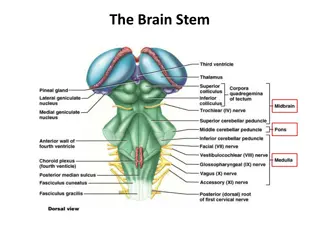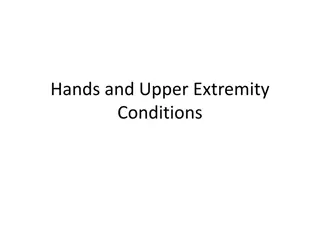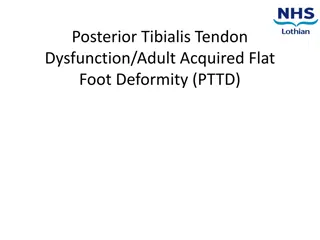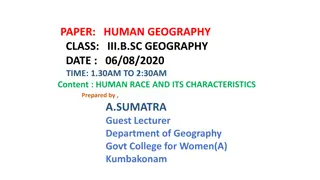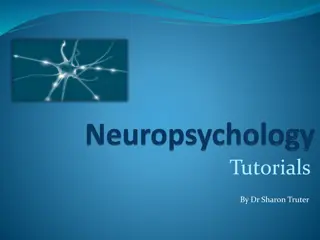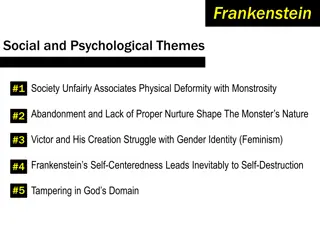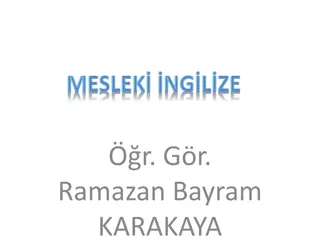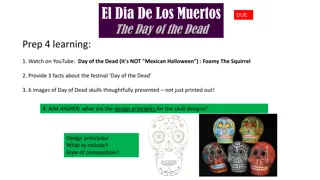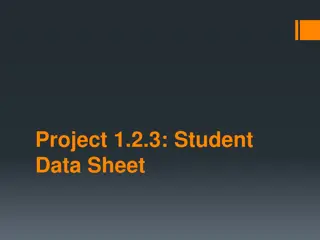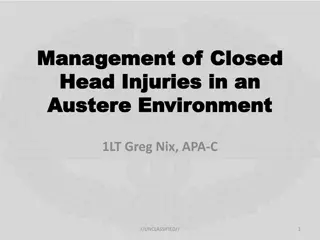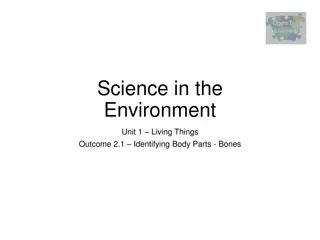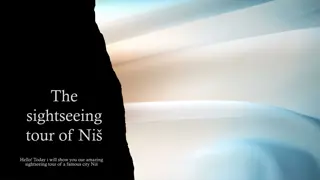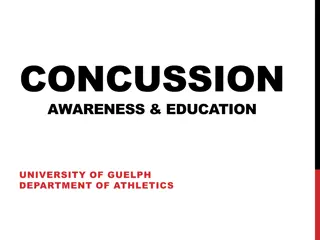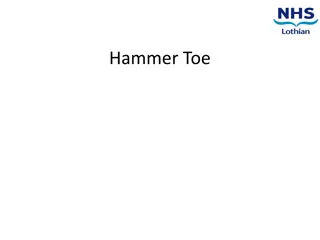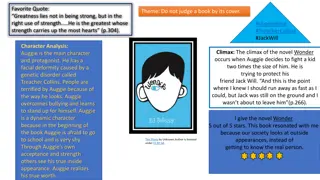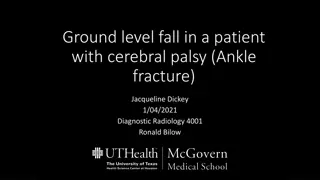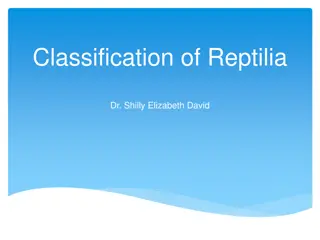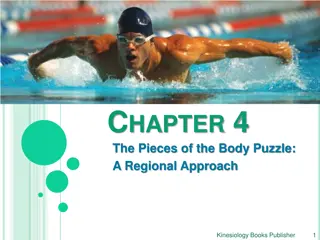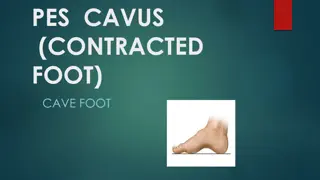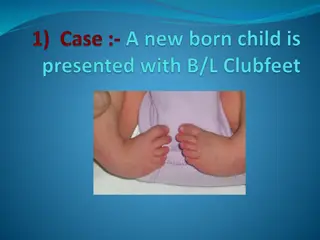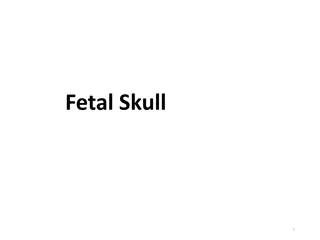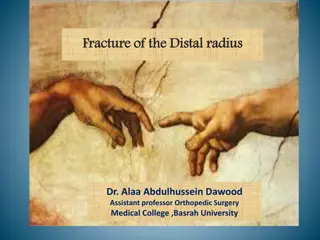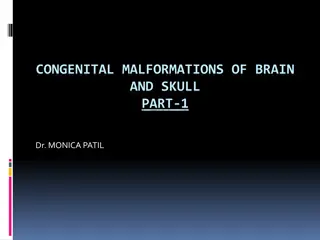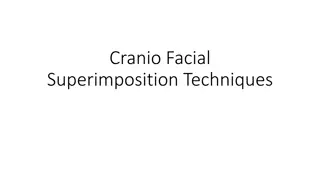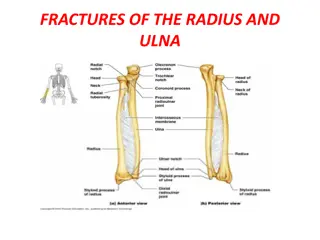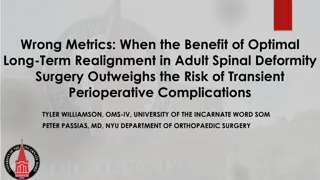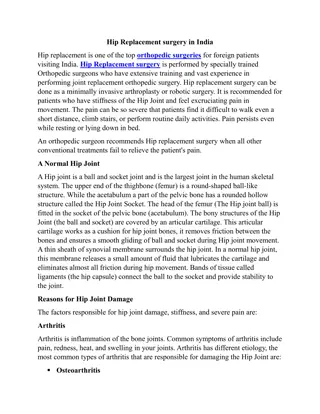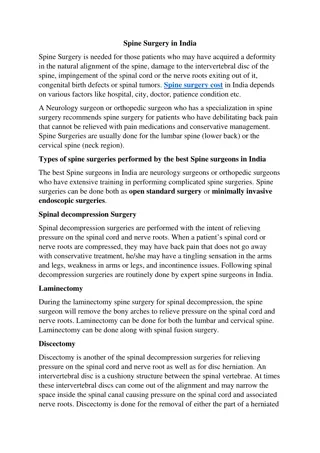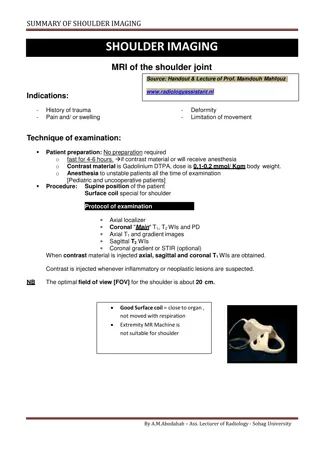Understanding Spondylodiscitis: Diagnosis, Treatment, and Prognosis
Spondylodiscitis is an infectious inflammation affecting the spine's discs and adjacent vertebrae, posing challenges due to potential complications like abscess formation. Early diagnosis and prompt treatment are crucial for a favorable outcome, focusing on infection eradication, pain management, de
0 views • 22 slides
Understanding the Brain Stem and its Functions
Explore the intricate structures of the brain stem, including the midbrain, pons, and medulla oblongata. Learn about the functions of the cerebellum, its role in controlling postural reflexes and producing skilled movements. Discover the thick tracts connecting the cerebellum to the brain stem and t
8 views • 20 slides
Understanding the Brain: Stem, Midbrain, Pons, Medulla, and Cerebellum Functions
Explore the complex structures and functions of the brain, including the brain stem, midbrain, pons, medulla, and cerebellum. Discover how these regions play crucial roles in controlling reflexes, movements, and vital functions like respiration and posture. Learn about the thick tracts connecting th
7 views • 21 slides
Comprehensive Overview of Maxillary Sinus Anatomy and Function
The maxillary sinus, also known as the antrum of Highmore, is a key structure in the paranasal air sinuses. Described first in 1651, it plays a vital role in skull lightening, voice resonance, and air filtration. This pyramidal-shaped sinus is lined with Schneiderian membrane and has complex vascula
1 views • 41 slides
Podiatrist's Role in Managing Foot Involvement in Rheumatic Diseases
Rheumatology encompasses over 200 conditions affecting the musculoskeletal system, with foot involvement being significant in conditions like RA and OA. Podiatrists play a crucial role in diagnosing, treating, and preventing foot problems associated with inflammatory arthritis, such as joint damage,
0 views • 20 slides
Overview of Hands and Upper Extremity Conditions
This informative content covers various hand and upper extremity conditions including nerve innervation, deformities, splints, and syndromes such as carpal tunnel syndrome and cubital tunnel syndrome. It discusses key nerves like the ulnar, median, and radial, their functions, associated deformities
1 views • 40 slides
Understanding Posterior Tibialis Tendon Dysfunction (PTTD) in Adults
Posterior Tibialis Tendon Dysfunction, also known as Adult Acquired Flat Foot Deformity (PTTD), is a condition that affects the tibialis posterior tendon, leading to reduced arch support. Common causes include obesity, trauma, age, and existing health conditions. Symptoms may include ankle pain, swe
0 views • 12 slides
Understanding Human Race: Characteristics and Divisions
Anthropologists recognize three to four basic races of man: Caucasian, Mongolian, Negroid, and others. Each race has distinctive physical characteristics like skull shape, facial features, and nose structure. This study aims to explore the variations in human races and their distinctive traits.
2 views • 12 slides
Understanding CSF Rhinorrhea and Its Etiology
Cerebrospinal fluid (CSF) rhinorrhea is caused by an osseous defect at the skull base, leading to a leak due to disruption of the dura mater and arachnoid. Trauma and iatrogenic factors are common causes, with non-traumatic cases often linked to high-pressure leaks or tumor growth. Diagnosis involve
0 views • 8 slides
Neuropsychology Tutorials and Study Tips by Dr. Sharon Truter
Dive into the world of neuropsychology with tutorials by Dr. Sharon Truter. These insightful sessions cover anatomy, pathology, and essential aspects for aspiring neuropsychologists. Receive expert guidance, study tips, and valuable resources to excel in your SACNA exam. Explore the fascinating real
0 views • 39 slides
Understanding Tuberculosis of Hip and Knee Joint Deformities
Tuberculosis can affect the hip and knee joints, leading to various deformities and complications if left untreated. Common sites of TB in knee joint, neglected cases due to hamstring contracture, path mechanics of deformity development, along with differential diagnoses and treatment options are di
0 views • 8 slides
Understanding Human Evolution: From Ancestral Lineage to Modern Hominids
Human evolution is a fascinating journey of change and development, where humans emerged as a distinct species. The theory of evolution highlights our common ancestry with other organisms, including chimpanzees. Evidence from fossils, genetics, and culture supports the idea of a shared ancestor amon
1 views • 23 slides
Themes of Society and Psychology in Frankenstein
Society unfairly associates physical deformity with monstrosity in Mary Shelley's novel, Frankenstein. The abandonment and lack of proper nurture shape the monster's nature, while Victor and his creation struggle with gender identity. Frankenstein's self-centeredness leads to self-destruction, and t
0 views • 14 slides
Visual Guide to Human Anatomy and Systems
Explore detailed images of human body parts and systems including face, thigh, head, hair, eye, nose, mouth, chest, arm, elbow, hand, leg, knee, foot, forehead, neck, ear, lip, tongue, tooth, teeth, finger, waist, calf, muscle-skeletal system, skull, shoulder, rib, spinal cord, hip, limbs, joints, a
0 views • 21 slides
Understanding Murder in Common Law
Murder, as defined in common law, is the unlawful killing of a human being with malice aforethought. This act involves both actus reus (unlawful killing caused by the defendant) and mens rea (intention to kill or cause grievous bodily harm). Legal causation, including thin skull test, chain of causa
0 views • 18 slides
First Aid Tips for Common Trauma Injuries
Learn how to manage various trauma injuries such as skull fractures, eye injuries, blowout fractures, epistaxis, mouth injuries, soft tissue injuries, open injuries, and penetrating wounds with practical first aid techniques. From treating bleeding and impaled objects to saving dislodged teeth and c
0 views • 16 slides
Understanding El Día de los Muertos: Festival and Skull Design Principles
Explore the significance of El Día de los Muertos, uncover three key facts about the festival, view creatively presented skull images, and delve into the design principles behind the iconic skull designs. Discover the artistic elements and cultural depth of this celebrated tradition.
0 views • 11 slides
Sex Determination Through Bone Analysis in Forensic Anthropology
In forensic anthropology, the pelvis and skull are crucial in sex determination, with additional assistance from femur, tibia, and humerus measurements. This data sheet guides on circling male or female based on traits like sub-pubic angle, pelvic cavity shape, eye orbit sharpness, zygomatic process
0 views • 33 slides
Management of Closed Head Injuries in an Austere Environment Overview
Understanding the pathophysiology of brain injuries, including intracranial pressure changes and specific injuries such as traumatic brain injury (TBI), skull fractures, brain bleeds, and diffuse axonal injuries. It covers classifications, diagnosis, and treatment approaches for mild/concussion, mod
0 views • 27 slides
Exploring Human Bones: An Introduction to the Skeletal System
In this unit, you will delve into the fascinating world of human bones. From the skull to the legs, discover the vital roles each bone plays in our body. Learn about the human skeleton, identify important bones, and understand the functions of key body parts. Engage with interactive activities and b
0 views • 10 slides
Explore the Wonders of Ni - A Sightseeing Adventure
Join the exciting sightseeing tour of Ni, featuring laughter-filled moments, a surprising gas station incident, a chilling visit to the Skull Tower, a fun mall exploration, an entertaining puppet show, and a beautiful art gallery near the Forum Mall. Indulge in delicious food at Todor Restaurant for
0 views • 13 slides
Concussion Awareness and Education at University of Guelph
A concussion is a form of head injury that occurs due to a direct or indirect hit to the head or body, causing the brain to shift within the skull. It is a transient neurological event with a course of complete recovery in most athletes. Despite no accurate biomarker, it is diagnosed clinically base
0 views • 27 slides
Understanding Hammer Toe: Causes, Symptoms, Diagnosis, and Management
Hammer toe is a flexion deformity of a toe that can cause discomfort and pain, often worsened by ill-fitting footwear or weight-bearing activity. The condition can be caused by factors like bunions, trauma, or toe joint instability. Symptoms may include pain at the joint of the affected toe and seco
0 views • 12 slides
Wonder Novel Review and Analysis
A comprehensive review and character analysis of the novel "Wonder" by R.J. Palacio. Explore the central themes of kindness, inner strength, and overcoming adversity through the protagonist, Auggie, who faces challenges due to a facial deformity. Witness the climax where Auggie stands up against bul
0 views • 4 slides
Ankle Fracture in a Patient with Cerebral Palsy: Diagnostic Radiology Case Study
A 57-year-old male with a history of cerebral palsy presented with ankle pain following a ground level fall. Examination revealed a Danis-Weber type B3 fracture subluxation and a displaced age-indeterminant fracture of the talar neck with midfoot collapse. Key imaging findings included soft tissue s
0 views • 15 slides
Understanding the Classification and Features of Reptiles
Reptiles belong to the Class Reptilia and are known for their cold-blooded nature, dry skin with epidermal scales, and unique skeletal features. They are classified into different subclasses and orders based on their characteristics. The distinct skull structures of anapsids and synapsids define the
0 views • 28 slides
Understanding the Regional Anatomy of the Body: A Kinesiology Perspective
Explore the intricacies of the human body's skeletal structure through a regional approach as outlined in kinesiology books. Delve into the axial and appendicular skeleton, facial muscles, skull anatomy, importance of wearing a helmet, facial bones, back region, and the vertebral column. Learn about
0 views • 12 slides
Understanding Pes Cavus: Causes, Symptoms, and Treatment Options
Pes Cavus, also known as contracted foot or cave foot, is a foot deformity characterized by an elevated medial longitudinal arch, causing the forefoot to be lower than the hindfoot. This condition can lead to pain, clawed toes, and other complications. Treatment options include orthotics, exercises
0 views • 7 slides
Club Foot (Congenital Talipes Equinovarus): A Comprehensive Overview
Club foot, also known as Congenital Talipes Equinovarus, is a condition characterized by a tri-planar deformity of the foot. This article covers the aetiology, clinical features, diagnosis, treatment options, and patient management strategies for club foot. It discusses the gene variations, environm
0 views • 26 slides
Understanding the Anatomy of the Fetal Skull
The fetal skull is a bony cavity that protects the delicate brain and plays a crucial role in the birthing process. This detailed guide explores the composition of the fetal skull, including the bones, sutures, fontanels, regions, and landmarks. Understanding these aspects is essential for assessing
0 views • 18 slides
Distal Radius Fracture: Diagnosis, Management, and Complications
Distal radius fractures, particularly Colles fractures, are common injuries, often affecting elderly women due to osteoporosis. These fractures typically result from a fall onto an outstretched hand, causing dorsal and sometimes radial displacement of the distal radius fragment. Clinical features in
0 views • 32 slides
Themes of Society and Psychology in Frankenstein
Society unfairly associates physical deformity with monstrosity in Frankenstein, shaping the monster's nature through abandonment and lack of nurture. The struggles of Victor and his creation with gender identity and self-centeredness lead to self-destruction, illustrating themes of tampering in God
0 views • 14 slides
Understanding Congenital Malformations of Brain and Skull Part 1: Embryology and Neurulation
This educational material explores the embryological development of brain and skull structures, focusing on neurulation processes, formation of brain vesicles, and potential errors leading to malformations. From neurulation initiation to neuronal proliferation and migration, the content delves into
0 views • 62 slides
Understanding Genu Varum (Bow Leg Deformity) and Its Management
Genu varum, or bow leg deformity, is characterized by lateral angulation of the tibia in relation to the knee, leading to a widened stance. Causes include early weight bearing, conditions like Blount's disease and rickets, and osteoarthritis in adults. Treatment options range from special shoes and
0 views • 6 slides
Cranio-Facial Superimposition Techniques in Forensic Anthropology
Cranio-facial superimposition is a technique used in forensic anthropology to identify a skull by overlaying an image of the skull onto a photograph or video of a missing person's face. This method involves various techniques such as photographic, video, and roentgenographic superimposition. The pro
0 views • 20 slides
Fractures of the Radius and Ulna: Mechanism, Clinical Features, and Treatment
Fractures of the radius and ulna commonly occur due to various forces like twisting, angulating, or direct blow. Symptoms include pain, swelling, and deformity, with potential circulatory or neural deficits. Diagnosis involves X-rays, and treatment varies for children and adults, from closed reducti
0 views • 31 slides
Benefit of Long-Term Realignment in Adult Spinal Deformity Surgery
Recent literature highlights the benefits of surgical intervention for adult spinal deformity, despite the potential for transient perioperative complications. This study aims to explore the long-term outcomes of optimal realignment in ASD surgery, emphasizing the significance of achieving improved
0 views • 14 slides
Hip Replacement surgery in India
Spine Surgery is needed for those patients who may have acquired a deformity in the natural alignment of the spine, damage to the intervertebral disc of the spine, impingement of the spinal cord or the nerve roots exiting out of it, congenital birth
1 views • 4 slides
Spine Surgery in India
Spine Surgery is needed for those patients who may have acquired a deformity in the natural alignment of the spine, damage to the intervertebral disc of the spine, impingement of the spinal cord or the nerve roots exiting out of it, congenital birth
0 views • 3 slides
Comprehensive Guide to Shoulder MRI Imaging and Interpretation
Shoulder MRI imaging is valuable for assessing trauma, pain, swelling, deformity, and movement limitations. This detailed guide covers patient preparation, examination techniques, protocol, and interpretation of shoulder scans including assessment of tendons, ligaments, bursae, and bones.
0 views • 12 slides

